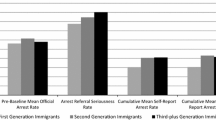Abstract
We compared measures of self-reported arrests and official arrests for 676young adults with a history of child abuse and/or neglect and 520 nonabusedand nonneglected controls matched on age, sex, race, and approximate familysocial class. Findings reveal considerable concurrent validity between thetwo sources overall. But there is also evidence of differences by gender,race/ethnicity, age at time of arrest, conviction status, and type ofoffense. Abused and neglected subjects did not appear to differ from thecontrol group in the extent of underreporting of known offenses, however,the groups did differ in the degree of “positive bias”—offensesnot found in arrest records. Abused/neglected subjects self-reportedproportionately more offenses not known to police compared to controls. Thisresult suggests that findings from previous studies on the relationshipbetween childhood victimization and later criminality, as measured byarrests, may have underestimated the magnitude of this relationship.
Similar content being viewed by others
References
Blumstein, A., Cohen, J., Roth, J. A., and Visher, C. A. (eds.) (1986). “Career Criminals,” National Academy Press, Washington, DC.
Bowling, B. (1990). Conceptual and methodological problems in measuring “race” differences in delinquency: A reply to Marianne Junger. Br. J. Criminol. 30(4): 483–492.
Chaiken, J. M., and Chaiken, M. R. (1982). Varieties of Criminal Behavior, Rand, Santa Monica, CA.
Elliott D. S. (1994). Serious violent offenders: Onset, developmental course, and termination. Criminology 32: 1–21.
Elliott, D. S., and Voss, H. L. (1974). Delinquency and Dropout, D. C. Heath, Lexington, MA.
Farrington, D. P., Loeber, R., Stouthamer-Loeber, M., Van Kammen, W. B., and Schmidt, L. (1996). Self-reported delinquency and a combined delinquency seriousness scale based on boys, mothers, and teachers: Concurrent and predictive validity for African-Americans and caucasians. Criminology 34: 493–518.
Geerken, M. R. (1994). Rap sheets in criminological research: Considerations and caveats. J. Quant. Criminol. 10: 3–21.
Hindelang, M. J., Hirschi, T., and Weis, J. G. (1979). Correlates of delinquency: The illusion of discrepancy between self-report and official measures. Am. Sociol. Rev. 44: 999–1014.
Hindelang, M. J., Hirschi, T., and Weis, J. G. (1981). Measuring Delinquency, Sage, Beverly Hills, CA.
Hirschi, T. (1969). Causes of Delinquency, University of California Press, Berkeley.
Hollingshead, A. B. (1975). Four Factor Index of Social Status, New Haven, CT (Yale University Working Paper).
Huizinga, D. (1991). Assessing violent behavior with self-reports. In Milner, J. S. (ed.), Neuropsychology of Aggression, Kluwer, Boston.
Huizinga, D., and Elliott, D. S. (1986). Reassessing the reliability and validity of self-report delinquency measures. J. Quant. Criminol. 24: 293–327.
Junger, M. (1989). Discrepancies between police and self-report data for Dutch racial minorities. Br. J. Criminol. 29: 273–284.
Lab, S. P., and Allen, R. B. (1984). Self-report and official measures: A further examination of the validity issue. J. Crim. Just. 12: 445–455.
Leventhal, J. M. (1982). Research strategies and methodologic standards in studies of risk factors for child abuse. Child Abuse Neglect 6: 113–123.
Marquis, K. H. (1981). Quality of Prisoner Self-Reports: Arrest and Conviction Response Errors, Rand, Santa Monica, CA.
Maltz, M. D. (1994). Deviating from the mean: The declining significance of significance. J. Res. Crime Delinq. 31: 434–463.
Maxfield, M. G., and Babbie, E. (1998). Research Methods for Criminal Justice and Criminology, 2nd ed., Wadsworth, Belmont, CA.
Maxfield, M. G., and Widom, C. S. (1996). The cycle of violence: Revisited six years later. Arch. Pediatr. Adolesc. Med. 150: 390–395.
Robins, L. N. (1978). Sturdy childhood predictors of adult antisocial behavior: Replications from longitudinal studies. Psychol. Med. 8: 611–622.
Robins, L. N., Helzer, J. E., Cottler, L., and Goldring, E. (1989). National Institute of Mental Health Diagnostic Interview Schedule, Version III Revised (DIS-III-R), Washington University, St. Louis, MO.
Sampson, R. J. (1985). Sex differences in self-reported delinquency and official records: A multiple-group structural modeling approach. J. Quant. Criminol. 1: 345–367.
Schulsinger, F., Mednick, S. A., and Knop, J. (1981). Longitudinal Research: Methods and Uses in Behavioral Sciences, Martinus Nijhoff, Boston.
Tracy, P. E. (1987). Race and class differences in official and self-reported delinquency. In Wolfgang, M. E., Thornberry, T. P., and Figlio, R. M. (eds.), From Boy to Man, From Delinquency to Crime, University of Chicago Press, Chicago, IL.
Weis, J. G. (1986). Issues in the measurement of criminal careers. In Blumstein, A., Cohen, J., Roth, J. A., and Visher, C. A. (eds.), Criminal Careers and “Career Criminals,” National Academy Press, Washington, DC, Vol. 2, pp. 1–51.
West, D. J., and Farrington, D. P. (1977). The Delinquent Way of Life, Heinemann, London.
Widom, C. S. (1984). Sex roles, criminality, and psychopathology. In Widom, C. S. (ed.), Sex Roles and Psychopathology, Plenum, New York, pp. 187–213.
Widom, C. S. (1989a). Child abuse, neglect and adult behavior: Research design and findings on criminality, violence, and child abuse. Am. J. Orthopsychiatry 59: 355–367.
Widom, C. S. (1989b). Child abuse, neglect, and violent criminal behavior. Criminology 27: 251–271.
Widom, C. S. (1989c). The cycle of violence. Science 244: 160–166.
Widom, C. S., and Morris, S. (1997). Accuracy of adult recollections of childhood victimization Part II: Childhood sexual abuse. Psychol. Assess. 9(1): 34–46.
Wolfgang, M. E., and Weiner, N. (1989). University of Pennsylvania Greater Philadelphia Area Study, Unpublished interview protocol.
Author information
Authors and Affiliations
Rights and permissions
About this article
Cite this article
Maxfield, M.G., Weiler, B.L. & Widom, C.S. Comparing Self-Reports and Official Records of Arrests. Journal of Quantitative Criminology 16, 87–110 (2000). https://doi.org/10.1023/A:1007577512038
Issue Date:
DOI: https://doi.org/10.1023/A:1007577512038




